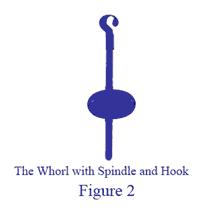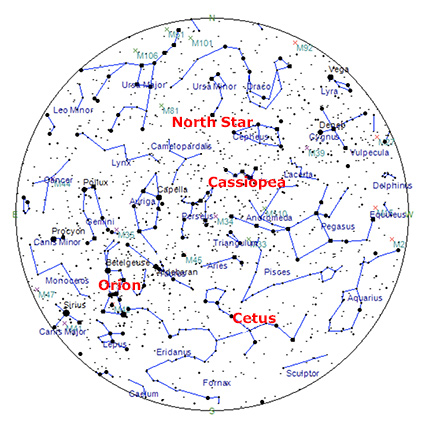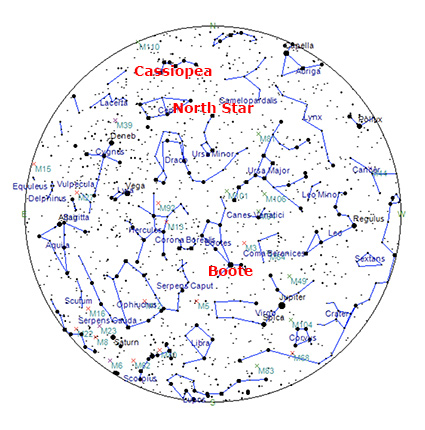The Voynich Manuscript’s Star Folios, Part II The decoding of the hieroglyphs among the stars of folio 68r2
The decoded hieroglyphs from the Voynich Manuscript’s star section f.68r2, like those around the Moon and Sun, suggest that the Earth, rotating around its polar axis, not only is the reason the stars appear to turn around the North Star, but is also directly related to the seasonal changes on Earth.
“The noblest pleasure is the joy of understanding”
— Leonardo da Vinci
Page 68r of the VM consists of three folios. The hieroglyphs in the illustrations of these three folios have been decoded, but time is required from my busy son and daughter to put them into a suitable form for release on the internet. I am therefore providing a brief account of what to expect when parts 1 and 3 are released.
Part 1, f.68r3 states that the author of the VM is a boy astronomer who has much to say about heavenly matters, but his family objects, saying he is squint eyed.
Part 2, f.68r2, discussed in this article, suggests that the rotation of the Earth around its axis is the reason why each star: 1) revolves daily around the stationary North Star and 2) rotates yearly to the same location at the same hour of the night.
Part 3, f.68r1, discusses the Earth revolving around the Sun and how much trouble he would be in if his ideas were disclosed to the church.
I am currently attempting to decode f.1. The first three words appear to state that the VM is the ‘Property of Italian Leonardo.’ I hope that Leonardo, in time for the 500th anniversary of his death in 1519, is recognized as a brilliant pioneer of astronomy.
Introduction: Astronomy is the oldest of the natural sciences dating back to before the early Greek astronomers. Plato and Ptolemy established the geocentric model of the solar system that was the law of the Roman Church in Europe until the late 16th century. Ptolemy named and identified many of the stars and constellations in the northern night sky. The star sections of f.68r3, f.68r2 and f.68r1 are complementary and should be read f.68r3 first, followed by f.68r2 and then f.68r1. These folios refute the geocentric system and replace it with the heliocentric system.
The following texts are the result of decoding Dante Italian dialect words using anagrams (see Appendix). As anagrams are degenerate, the astronomical folio 68r2, being related to stars, was selected in order to simplify decoding and interpretation. The Voynich astronomical folio 68r2 consists of three parts: the Moon, Stars and the Sun, Figure 1.

The translations of the decoded hieroglyphs from around the Moon, Sun and among the Stars are given below:
- f.68r2 Moon: I am turning round, a sign I am the one, it is sunbeam shaking except high scaffold sunbeams(i)
- f.68r2 Stars: I have belonging to the sun both the south wind from the summer season with the dawn or day star as Kocab flying by wreath the distaff to spin faire North Star and roundelaie flying about the heart of the pole or the Earth I am wheeled or turned Ceto and the northeast wind of the north with Orion it had in that place roule the Boote and where Cassiopea is about the seven stars about the North Star.
- f.68r2 Sun: that it is found and the fashion, much by a chance, sunbeams shaking or whether by the earth turning.(ii)
The words, decoded from around the faces of the Moon and Sun, are discussed in an earlier article.(iii) See the appendix for transcription details of the hieroglyphs scattered among the stars.
The decoded text of the hieroglyphs scattered among the stars requires explanation. To begin with, some of the words translated using Florio’s 1611 Italian-English dictionary have changed in meaning or become obsolete.
‘I have belonging to the sun both the south wind from the summer season with the dawn or day star(1). As Kocab(2) flying by encircling(3) the spindle(4) to spin faire North Star(2), and in a slow circular dance(5) flying about the heart of the pole, or the Earth I am wheeled(6) or turned Ceto(7) and the northeast wind(8) of the north with Orion(9), it had in that place roll(10) the Boote(11) and where Cassiopea(12) is about the seven stars about the North Star(2).’
- The Day Star was called Lucifer, the planet Venus, visible in the East before dawn.
- Kocab or Kochab and Pherkad are stars in the bowl of the Little Dipper, Ursa Minor, that consists of seven stars including the North Star. Pherkad is referred to later. The North Star lies in the sky almost directly above the North Pole and therefore appears to be stationary.
- Wreath means encircling.
- Distaff is a spindle or stick to use to spin.
- Rounddelaie is a slow circular dance.
- Wheeled, rotated and revolved. The Earth rotates around its axis and revolves around the Sun.(iv)
- Cetus is the Whale constellation.
- Borea is the northeast wind, but also the name of the god of winter who swept down from the cold mountains of Thrake (Thrace), chilling the air with his icy breath.(v)
- Orion is the Hunter constellation.
- Roule is an old English term meaning roll.
- Bootes is the Herdsman constellation.
- Cassiopea is a constellation named after a vain Greek queen.

The spindle refers to Plato’s ‘Spindle of Necessity.’ A Greek spindle consisted of three parts: a hook, shaft (pole) and whorl (disc), Figure 2. Plato and his student Aristotle proposed that the Sun, Moon, planets and stars revolved on eight orbits around a stationary, spherical Earth. The spindle was attended to by the Sirens and turned by the three Fates. The Earth was located at the center of the spindle. The stationary North Star, a giant celestial sphere, caused the orbits of the Sun, Moon, planets and stars on the whorl to revolve daily around Earth(vi). Plato’s stationary Earth on the ‘Spindle of Necessity’ was later adopted by the 2nd century Greek astronomer Ptolemy and was known as the Ptolemaic or geocentric model of the universe. It was in accordance with the teachings of the scriptures. The geocentric model prevailed until the middle of the 16th century when Copernicus’ heliocentric model of the universe became generally accepted.(vii)
Ptolemy and Plato’s geocentric model, ‘as Kocab flying by encircling the spindle’ describes the stars of the Little Dipper revolving around a celestial spindle in order to spin the North Star. The North Star is the only bright star in the northern sky, whose position does not change relative to the rotating Earth. It is located directly above the North Pole near the North Celestial Pole, the point around which the entire northern sky appears to turn. It was used for navigation. Two stars above, Kocab and Pherkad, were used to tell the time at night as they circled around the North Star like the hand of a 24-hour clock.(viii)
Just as Kocab and Pherkad act as the hand of a 24-hour clock as they circle the North Star, the constellations that are not circumpolar like Cetus, Orion and Boote may act as a crude calendar as they are present or absent at different stages of the Earth’s orbit of the Sun. The circumpolar constellation Cassiopea never sets in the sky of the northern hemisphere. The above statement describes how as the ‘Northeast wind of the North’ blows in, Cetus followed by Orion appear in the southern part of the northern sky, Figure 3a. With the return summer season, Cetus and Orion are absent, and in their ‘place rolls Boote’, Figure 3b. Figures 3a and 3b depict the circumpolar constellation, Cassiopea, orbiting the North Star. (See: Circumpolar Stars, Wikipedia, for a video showing the circumpolar stars orbiting the North Star.) Cassiopea may be identified by its W shape.

Skymap of Florence, Italy; Dec 22 10pm

Skymap of Florence, Italy; June 22 10pm
The Earth tilting 23.50 degrees from the plane of its orbit, causes:
- The seasons to change as the Earth orbits the Sun.
- The summer solstice circumpolar stars to be 12 hours out of phase with those in the winter solstice.
The Earth’s tilt was known to the Ancient Greeks and measured in 1437 by the Persian astronomer Ulugh Beg.(ix) It is not clear whether the V.M.’s author was aware of the tilt, but he was correct to associate the changing of the seasons with the Earth orbiting the Sun. The constellations Cetus, Orion and Boote are listed in the order they are best seen in the northern night sky, in autumn, winter and late spring, respectively. As the Earth orbits the Sun, they move in and out of view at a speed that depends on their distance from the North Celestial Pole, the greater the distance, the greater the speed.
Cetus, the Whale, is one of the largest constellations, located close to the ecliptic, the imaginary line the Sun travels across the heavens. Cetus is so large it is only completely visible from October to January.(x)
Orion, the Hunter, is the most distinctive constellation in the northern night sky during the winter. It is located on the celestial equator. The famous Orion’s Belt makes Orion easy to identify.(xi)
Boote, the Herdsman, lies close to the Big and Little Dippers (in Ursa Major and Minor, the Greater and Lesser Bears). It was often called the Watcher of the Bear and contains the third brightest star in the sky, Arcturus. It is best seen in June.(xii)
Cassiopea, queen of the sky, lies opposite the Big Dipper and is visible all the year round. The five bright stars in the shape of a ‘W’ make it easy to identify.(xiii)
These constellations were probably chosen because of the times of year they are visible in conjunction with one or more distinctive features, like size, having bright stars or an unusual shape.
Conclusions: I expected the star hieroglyphs to provide a mundane list of star and constellation names that would confirm:
- Translating using the AVA alphabet.
- Decoding using anagrams.
- Translation using Florios 1611 Italian-English dictionary.(xiv)
This method decoded the names of 110 of the VM’s plants.(xv) The names of seven stars or constellations are identified by this procedure. In addition the VM’s author correctly theorized that the Earth rotating and orbiting the Sun is the reason why Kocab appears to fly in a slow circular dance around the pole and the seasons change. This was contrary to the geocentric model of the universe and the teachings of the 15th century church. It was heresy, possibly punishable by death and therefore no surprise that a code was used to hide the content of the VM.
Does Folio 68r2’s statement from around the drawing of a Moon’s face or the words among the stars, provide the required physical evidence to prove that the Earth is rotating? This is a matter for astronomers to decide. The only physical evidence available today that the Earth rotates while orbiting the Sun is stellar parallax, the apparent shift in position of any nearby star relative to the background of distant stars. This displacement is very small because stars are a long way from the Earth. Early astronomers, lacking adequate optical instruments, were unable to detect stellar parallax and therefore concluded that the Earth is stationary. Many of Galileo’s fellow scientists, including Tycho Brahe, rejected heliocentrism because stellar parallax could not be observed. It was only in 1838, that Bessel was able to measure stellar parallax and provided the first and only physical evidence that the Earth orbits the Sun.
The hieroglyphs were decoded using the following procedure:
- Each hieroglyph was transcribed using my AVA alphabet.(xvi)
- The transcribed word was decoded using an anagram website. Anagrams are degenerate and may result in one, several or no solution at all due to incorrect spelling, the combining of two or more words, or splitting one long word into two or three words.(xvii)
- The decoded word was translated into English using Florio’s 1611 Italian-English Dictionary.(xviii)
- Some decoded words were abandoned because the word was not present in the dictionary.
- Some words from Florio’s dictionary have become obsolete, or their meaning has changed or can have multiple meanings.
These are some of the difficulties I encountered decoding the star hieroglyphs. I realized that as the text was related to stars, only decoded words that agreed with this premise should be accepted.
The 24 hieroglyphs, number 5 is a combination of two hieroglyphs, had to be put into an order that made sense. The numbers in Figure 1 represent the order used in this article. These 24 hieroglyphs, generally in pairs, turn counterclockwise around the center of the drawing. The stars associated with the numbers would therefore also rotate counterclockwise around the central star, the North Star. This is what you would see looking north in the northern night sky. The number of hieroglyphs, 24, may also represent the approximate time it takes for the Earth to rotate around its axis.
It is one thing to decode isolated words, but another to produce a logical statement from 23 random words. There is no way I could have dreamed up this text. It validates the AVA alphabet used to transcribe these Italian hieroglyphs and anagrams to decode them. Decoding this manuscript will not be easy. Part 1 states that the VM was written by a boy astronomer. It therefore probably represents Leonardo da Vinci’s first notebook, written in his youth, discussing topics that may have resulted in difficulties or retribution from the church if read by the wrong person. A notebook he used to record observations of the physical world around him but never intended for others to read.
I have belonging to the sun both the south wind from the summer season with the dawn or day star as Kocab flying by wreath the distaff to spin faire North Star and roundelaie flying about the heart of the pole or the Earth I am wheeled or turned Ceto and the northeast wind of the north with Orion, it had in that place roule the Boote and where Cassiopea is about the seven stars about the North Star.
| # | VM glyphs | Transcription | Decoding |
Florio’s 1611 Italian-English dictionary |
| 1 |  |
oloichea | Ho Eliaco |
 
|
| 2 |  |
obam | ambo |

|
| 3 |  |
ceoroi | I Coro E |
  AND |
| 4 |  |
Tebas | Ab est |
 
|
| 5 |
 
|
Bcoi obarau ia |
Coi Alba O iubar |
   
|
| 6 |  |
Oabca | A Ocab |
 Kocab or Kochab |
| 7 |  |
Oleovi | Volo A |
 
|
| 8 |  |
Otlcor | Torc Lo |
  
|
| 9 |  |
Coiar | Rocia |

|
| 10 |  |
Bcuoiba | Bei Boca |
 
|
| 11 |  |
Olceoba | E Cobalo |
And
|
| 12 |  |
Olavo | Volo a |
 
|
| 13 |  |
Op color | Cor Polo |
 
|
| 14 |  |
Oloteoi | O Telo Io |
Or I am |
| 15 |  |
Otlueeor | Roteuolo |

|
| 16 |  |
Teca | Ceta |

|
| 17 |  |
Eeobra | E Borea |
And
|
| 18 |  |
Olceobar | Boreal Co |
 
|
| 19 |  |
Obenr eeoi |
Orione ebe |
 
|
| 20 |  |
Olevor | Ve Rolo |
 
|
| 21 |  |
Otleeeoba | La Boote E |
The And |
| 22 |  |
Oicusea | U Cassio E |
  Is |
| 23 |  |
Acora | A Caro |
 
|
Acknowledgements: I want to thank my husband for his help in understanding the astronomy that was required to write this article. We found the Sky Map website exceptionally useful. I am sure Rene Zandbergen can attest to how little astronomy I know and hope he will point out any errors I may have made. I would also like to thank my son Kevin and daughter Erica for coding up this article, they do a great job! I would also like to thank the Beinecke Library for providing access and the use of their excellent reproductions of the VM and providing me with many years of interest and work. The more of the VM I decode, the more interesting it becomes.
- ↑ back http://www.edithsherwood.com/astro-folios-68/
- ↑ back http://www.edithsherwood.com/astro-folios-68/
- ↑ back http://www.edithsherwood.com/astro-folios-68/
- ↑ back Defining Rotation and Revolution of the Earth
- ↑ back Boreas, Greek god of the north wind and winter
- ↑ back Plato describes the planets
- ↑ back Early Astronomers: Ptolemy, Aristotle, Copernicus, and Galileo
- ↑ back Dennis Mammana, How to Tell Time by the Big Dipper
- ↑ back Ulugh Beg, Wikipedia
- ↑ back Universe Today
- ↑ back Universe Today
- ↑ back Universe Today
- ↑ back Universe Today
- ↑ back Florio’s 1611 Italian-English dictionary
- ↑ back http://www.edithsherwood.com/voynich-botanical-plant-anagrams/
- ↑ back http://www.edithsherwood.com/voynich-botanical-plant-anagrams/
- ↑ back http://www.edithsherwood.com/voynich-botanical-plant-anagrams/
- ↑ back Florio’s 1611 Italian-English dictionary